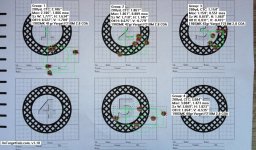Shredder, that's right on large vs. small groups. The proof is firing 20, 30 or even 40 shot test groups. Note also that if a given load doesn't produce the same size groups all the time (within 10% extreme spread), you're not shooting enough shots per group to make them at least 90% represent the real accuracy of your stuff as you shoot it.
Your bullet's seated out too far when:
* the round won't fit in and load reliably from the magazine.
* bolt won't close easily on the round as it jambs into the rifling.
* it's not held good enough by the case neck to withstand normal handling and works loose from being seated to shallow.
Your bullet's seated out too far when:
* the round won't fit in and load reliably from the magazine.
* bolt won't close easily on the round as it jambs into the rifling.
* it's not held good enough by the case neck to withstand normal handling and works loose from being seated to shallow.

